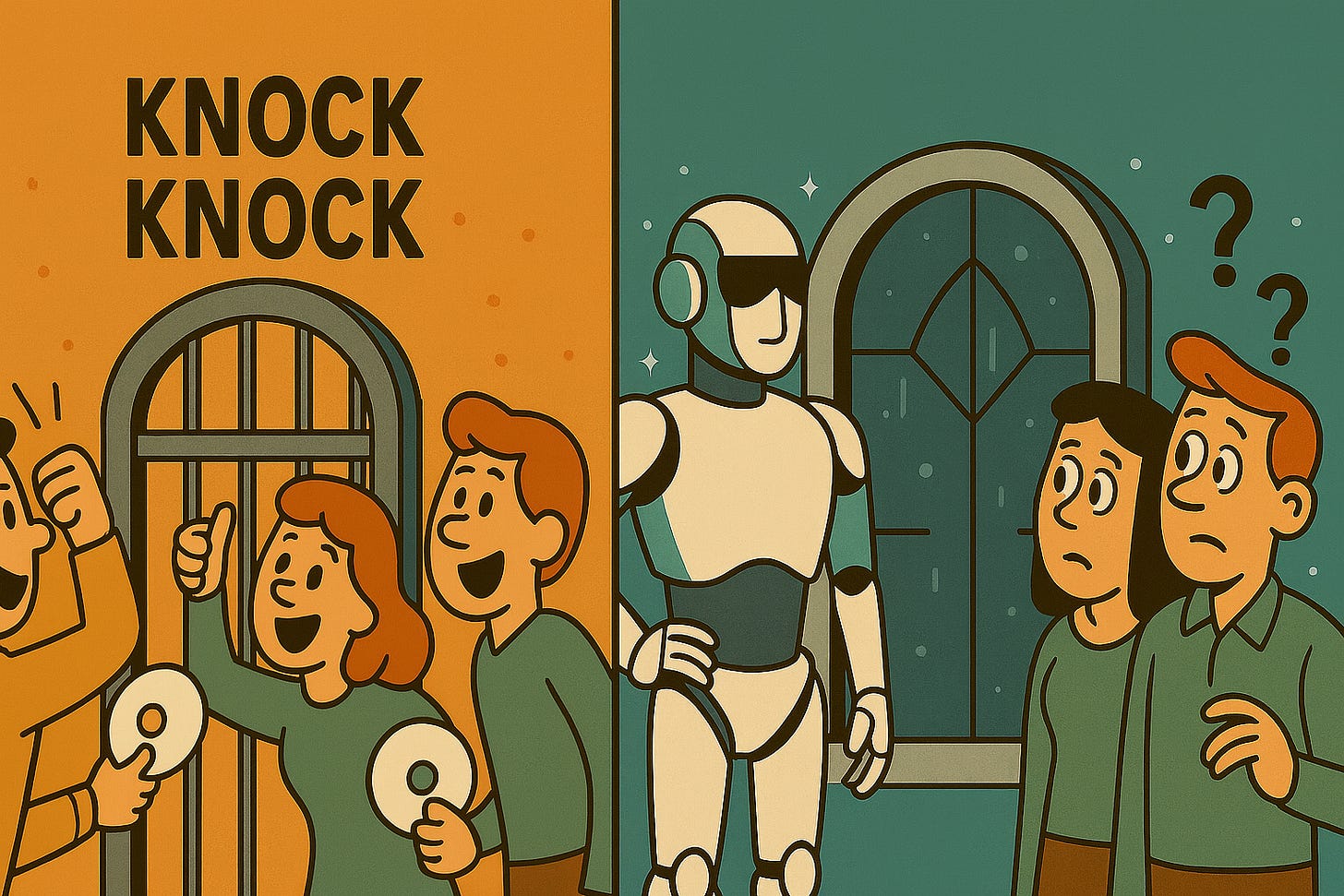Is AI’s ‘Eternal September’ right around the corner? What AOL and GPT-5 tell us
Adoption isn’t a monolithic function of technical depth; it also requires lowering of use barriers
I've spent years watching technology waves crash against the shores of human adoption, and I'm fascinated by a parallel between two seemingly unrelated events: AOL's recent shutdown of dial-up services and OpenAI's GPT-5 announcement. Both connect to a deeper story about how transformative technologies either do or don't reach the masses – a story that begins with something called "Eternal September."
The Legend of Eternal September: When Gatekeepers Fall
Picture the early internet as an exclusive club. Usenet, the precursor to modern online communities, operated with unwritten rules and established hierarchies. (My usenet username is still etched in my brain, FWIW) Every September brought a predictable influx of college freshmen getting their first internet access – they'd ask obvious questions, break social norms, and generally disrupt the established order. But by October, they'd either adapted or disappeared, and the community would return to its comfortable equilibrium.
September 1993 shattered this cycle forever. AOL opened the floodgates, giving millions of everyday Americans access to Usenet. The September never ended because the barriers to entry had fundamentally collapsed. What emerged wasn't just more users – it was a completely different internet, shaped by mass participation rather than elite gatekeeping.
True technological revolutions aren't just about better tools – they're about eliminated barriers creating entirely new user behaviors.
AOL's Quiet Revolution: The Power of Radical Simplification
Looking back at AOL's 30-year dial-up journey ending, I'm struck by their unexpected (to their contemporaries, at least) understanding of something we've forgotten in our rush toward AI sophistication. AOL didn't win by being the most technically advanced – they won by being radically simple.
Those infamous CD-ROMs weren't just marketing gimmicks; they were physical manifestations of AOL's core insight: the biggest barrier to internet adoption wasn't bandwidth or even cost – it was intimidation. While competitors focused on faster modems and better compression algorithms, AOL created a complete experience ecosystem. They understood that your grandmother didn't want to learn about TCP/IP settings; she wanted to email her grandchildren and maybe join a gardening chat room. CompuServe and Prodigy were attempting the same - CompuServe being the average users, over priced archaic access point; while Prodigy served as a primordial proof point that first mover advantage, in this case AOL, would accrue the most success.
AOL's genius lay in creating what I call "invisible infrastructure" – technology that works so seamlessly that users forget they're using technology at all. They abstracted away complexity and created familiarity where none existed before.
Market transformation happens when technology becomes so intuitive that it disappears, leaving only enhanced human capability.
The AI Paradox: Powerful Yet Inaccessible
Which brings us to our current moment. OpenAI's GPT-5 promises unprecedented capabilities – reasoning that approaches human-level performance, context understanding that spans entire documents, creative outputs that rival professional work. The technical achievement is undeniably remarkable.
Yet I see a profound disconnect between AI's promise and its practical adoption. Despite ChatGPT's record-breaking user growth, most non-technical interactions I observe remain superficial. People ask it to write emails or summarize articles – tasks that, while useful, barely scratch the surface of transformative potential.
The deeper challenge isn't awareness or access – it's that we're asking average users to become prompt engineers. Not everyone can be Carnac the Magnificent. We're expecting them to understand how to structure questions, provide context, and iterate on responses. We've created incredibly sophisticated tools while maintaining inherently complex interfaces.
This isn't AI's "Eternal September" moment – it's more like September 1990, when only computer science students knew how to navigate the internet.
The Missing Bridge: From Capability to Transformation
Having watched enterprise software adoption patterns for decades, I recognize this phase. We're in what I call the "capability plateau" – where technological advancement continues but user transformation stagnates because the bridge between power and accessibility remains unbuilt.
The companies that will create AI's true democratization moment won't necessarily have the most sophisticated models. They'll have the most sophisticated understanding of human needs and behaviors. They'll focus on:
Contextual Intelligence: Systems that understand not just what users ask, but what they actually need based on their situation, role, and goals.
Progressive Disclosure: Interfaces that gradually reveal complexity as users develop sophistication, rather than demanding expertise upfront.
Embedded Integration: AI that lives within existing workflows rather than requiring separate platforms and context-switching.
Outcome Orientation: Tools focused on helping users achieve specific goals rather than demonstrating general capabilities.
The next breakthrough will come from radical user empathy, not radical technical advancement.
Questions for the Next Wave of Innovation
As we stand at this inflection point, I find myself asking questions that go beyond technical capabilities:
Human-Centered Design: What would AI look like if we designed it for a 65-year-old small business owner rather than a 25-year-old software engineer?
Integration Strategy: How might we embed intelligence so seamlessly into existing tools that users gain AI benefits without learning "AI skills"?
Success Redefinition: What if we measured AI success not by model parameters or benchmark scores, but by the number of people whose daily capabilities were genuinely enhanced?
Distribution Innovation: Who will create the "CD-ROM moment" for AI – the simple, physical, tangible way to put transformative capability directly into people's hands?
Behavioral Change: What new human behaviors and social patterns will emerge when AI becomes as invisible and essential as electricity?
The opportunity before us is profound. Just as AOL's Eternal September fundamentally changed who the internet was for, AI's eventual democratization will reshape human potential itself. The question isn't whether this transformation will happen – it's whether we'll be bold enough to prioritize human empowerment over technical impressiveness.
The revolution is waiting. We just need to remember that the most transformative technologies are the ones that fade into the background, leaving only enhanced human beings in their wake.


